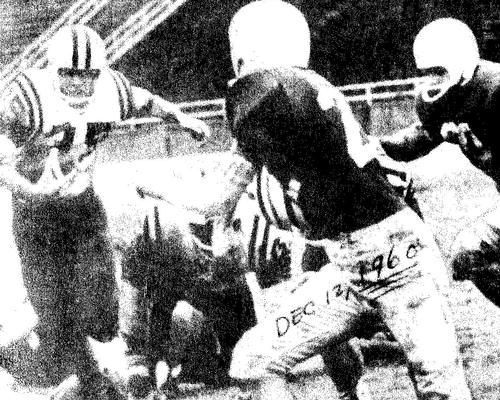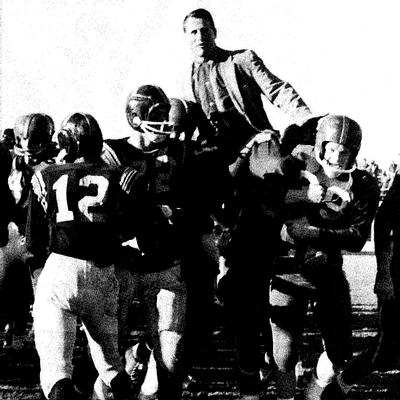There are successful high school coaches everywhere and I have to
believe that most still view coaching as teaching and football as a
vehicle to instill values and present lessons that will be useful for a
lifetime. I also know that in some parts of the country, high school
coaches are paid an inordinate amount of money to do nothing else but win
football games and they view their role similarly to college coaches. In a
culture of celebrity where substance of character is secondary to being
known, being accepted, being noticed, and being "somebody", football as
the last bastion of character-building is becoming an eroding edifice.
In the 1950's and 1960's most football coaches as did most men in any
profession, had a military background. The huge influx of men that the
military required for World War II, the Occupation, the quick to follow
Korean War, and the build-up of US manpower in Viet Nam that began in
1963 obviously meant that most adult males during this time period had
served their country at home or abroad. Their military background allowed
them to apply the values and techniques they had either learned or
experienced so that they could lead a group of young men towards a
commonly held goal. There was a strong reliance on physical conditioning,
in part due to the demands of the game of football which required all
participants to play both offense and defense and often on special teams,
and in part due to the value in mentally toughening the
group. Accompanying the psychological aspects of a demanding conditioning
program was the direct effect of bringing the group together as they
worked hard to achieve their common objectives. The goals of the
individual were subjugated to the goals of the group and nothing was as
important as "the team." Coaches like Emfinger's Gordon Wood, recognized
by many as the best and most successful high school coach of all time,
were true teachers of both football and values that were consistent with
the society at large and the communities they lived in.
Today's conditioning programs, despite the input of legitimate
scientific research, the most accurate of biomechanically designed
exercise machines, and the supervision of degreed strength coaches, pale
in comparison to those of the mid 1950's to mid-1960's. When high school
players do no more than man the offensive right tackle position and
sometimes not in passing situations, there is no need for heavy-duty
physical conditioning and because of that, many lessons are lost. Now, one
look at any pro football game quickly projects the need and expectation
that almost every player has for individual achievement and recognition.
There are extremes like Terrell Owens but watch special teams play to
immediately know that the game reflects the lowest common denominator of
the culture. It is a given that most special teams players are not
starters, they are men hanging on at the fringes of the roster, men that
must make the very most of any and every game day opportunity. They are
fortunate to "get a look" on special teams because they have yet to show
enough ability or consistency to play a "regular position" as a starter.
Yet, in making a tackle, doing nothing more than their required job,
something that must be done in order to continue their career as a
professional football player, they will shake, bake, quake, and
demonstrate in order to bring attention to their most minor individual act
or achievement. Note too that they'll ignore the fact that their team may
be losing by four touchdowns at the time! At the professional level, it
might be justified by some as being part of the entertainment product
that the game has to be in order to attract fans although to those who
respect the game itself, it isn't truly tolerable. At the collegiate and
high school levels the behavior and lack of team oriented focus is
unacceptable yet a fact of modern life.
It falls to the coaches to convey the true value of the game and to
take the responsibility to teach not only the techniques specific to a
position or the strategy of a particular offense, but of the possible life
lessons inherent to the game. When multi-million dollar per year coaches
also view themselves as rock stars or media celebrities, you can believe
this is a lost cause and when true believers in the value of the game
scratch their heads and wonder why the game has changed, it is the
celebrity, the money, and the need for individual attention. The allure
and value in the offerings that HELMET HUT brings to those who love
football is often overlooked. The vast array of collegiate helmets not
only traces the suspension-era history of each school, but serves as a
reminder of how the game used to be played and what it stood for. A quick
glance at one's helmet display can refresh each day and inject enthusiasm
for any daily task as memories of teams-past flash through the mind,
recalling the dedication and sacrifice that resulted in a shared victory
or common goal. A HELMET HUT purple KANSAS STATE helmet from 1972-73 could
remind one of Steve Grogan and his gallant play against stifling odds each
week and the fact that the Wildcats persevered to finally establish
themselves as a consistent collegiate power for years. The excellence one
strives for in all activity can be viewed in the collection of 1970's
OKLAHOMA UNIVERSITY helmets. In many ways, HELMET HUT provides a sense of
history and a sense of cultural sensibility, reminders that important
values can remain in the forefront.



